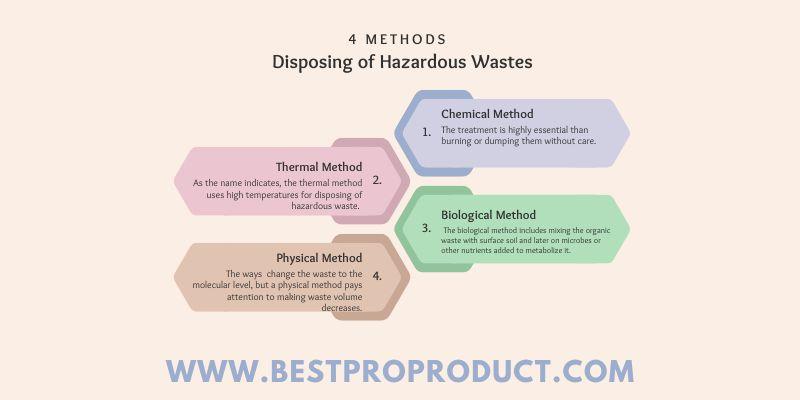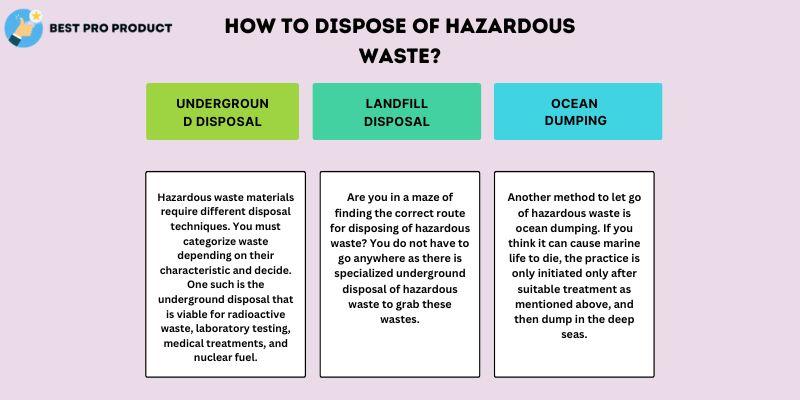Do you keep dumping everything into the bins without knowing it may contain hazardous waste? You need to be conscious and must find an authentic answer to How to Dispose of Hazardous Waste? The following disposal methods are my gathered knowledge. If you find it interesting, read to the end.
Hazardous waste demands careful disposal. If not, it may pollute the environment, cause marine life death, and severe health issues. The only way you can stop this long-lasting devastation is by proper storage, treatment, and disposal methods.
Hazardous waste is not only disposed of but it can be stored or treated to reduce it. The article demonstrates primary ways to dispose of hazardous waste. In addition, you may find alternatives or different storage and treatment techniques that prove effective for its reduction.
What are Four Methods for Disposing of Hazardous Wastes?
The disposal of hazardous waste in an adequate way reflects a pollution-free environment. No matter what treatment of hazardous waste you use, thermal, chemical, physical, or biological, remember to apply them depending on the nature of the waste.

Chemical Method
The chemical methods follow the ways to treat hazardous waste so the result with be a reduced amount. The treatment is highly essential than burning or dumping them without care.
- Ion exchange
- Neutralization
- Precipitation
- Oxidation and reduction
Thermal Method
As the name indicates, the thermal method uses high temperatures for disposing of hazardous waste. It includes incinerators that work in unison with incineration tools and detoxify or destroy the waste.
But the method has both positives and negatives. The former includes the destruction of waste in any form, be it solid, liquid, or sludge. On the other hand, you never know that this-way disposal may increase air pollution at an alarming pace.
Biological Method
Another method by which you can confirm the adequate disposal of hazardous organic waste is by treating them using a technique called landfarming. The biological method includes mixing the organic waste with surface soil and later on microbes or other nutrients added to metabolize it.
However, you should keep in mind that not all land is put at risk to do the task but a piece of it. Furthermore, the activity is kept separated from the land where food or crops grows.
Physical Method
Different hazardous waste undergoes different disposal methods, similarly, a variety of waste is treated with physical methods, such as evaporation, flotation, sedimentation, and filtration. The ways mentioned above change the waste to the molecular level, but a physical method pays attention to making waste volume decreases.
One such example of a physical method is solidification. The procedure proceeds by encapsulating hazardous waste into plastic and concrete, to make it a solid material resistant to leaching. Sometimes, the waste is mixed with water or lime to form a cement-like solid product which is usually harmless.
How to Dispose of Hazardous Waste?
Hazardous waste includes everything that is reactive, corrosive, ignitable, and toxic. It can be anything from art supplies and electronic gadgets to radioactive waste. You can use the following conventional disposal methods but with several limits.

Underground Disposal
Hazardous waste materials require different disposal techniques. You must categorize waste depending on their characteristic and decide. One such is the underground disposal that is viable for radioactive waste, laboratory testing, medical treatments, and nuclear fuel.
Specific mining sites accept these kinds of waste and in most cases, you find it the most cost-effective option. However, you must remember that the waste must be in an inactive or partially active state.
Landfill Disposal
Are you in a maze of finding the correct route for disposing of hazardous waste? You do not have to go anywhere as there is specialized underground disposal of hazardous waste to grab these wastes.
These dumpsites and landfills are excavated to prevent waste piling from upwards. Moreover, the underground landfills are lined with effective materials like clay, HDPE, or non-porous to prevent leaching and ensure that humankind contacts the waste as less as possible.
Ocean Dumping
Another method to let go of hazardous waste is ocean dumping. If you think it can cause marine life to die, the practice is only initiated only after suitable treatment as mentioned above, and then dump in the deep seas.
Hazardous Waste Storage Guidelines
In case, you do not find an organized way of disposing hazardous materials, there are a few guidelines you can adopt to store them. For this, you may get help from the storage information mentioned on the product’s label.
- Start storing the waste in the container it comes in; close the lid tightly
- Place the containers away from moisture to prevent corrosion, but in ventilated space
- Protect the label from going misplaced or out of sight
- Keep the containers on high shelves, or locked drawers
- Protect stored waste from children.
- Never mix chemicals or waste, for it may result in an abrasive reaction.
Alternatives for Hazardous Waste Disposal
Hazardous waste disposals are challenging, time taking, and tiring. Why not learn a few alternatives so that the waste no more remains hazardous? In this regard, recycling, reusing, or burning to recover energy are desirable, still, they are not declared as the final result of disposal.
The advantage of the alternatives is that they not only reduce the demand for hazardous waste but also the production. There must be appropriate recycling techniques to let you use the product again with high hopes.
Note: If you possess expired baking soda and need guidance on its disposal, then read this guide, How to Dispose of Baking Soda.
Mindful Tips
- Always buy the products in less amount
- Utilize the product fully so there is no need to discard or store
- Relay on using non-toxic substitutes
- You may also proceed for donating to service organizations or neighbors, such as paint, or cleaners
- Rinse the containers many times before throwing them in trash cans
- Do not put liquid waste into septic tanks.
Why is it Important to Dispose of Hazardous Waste Properly?
Disposing of hazardous waste properly is important in every condition. Otherwise, it may have the long-term impact of polluting the environment, contaminating the wastewater treatment plants, and posing serious health issues.
How Do You Neutralize Hazardous Waste?
You can neutralize hazardous waste by a controlled chemical reaction between acid and alkaline. The result will be a non-hazardous product, you call water or insoluble salts.
Summing Up
You must pay attention to the disposal of hazardous waste to reduce its negative impact. In this article, I have mentioned four disposal treatments and three methods to eliminate harmful material safely. In addition, give a glance at several alternatives and storage guides to make the best use of the substances as compared to allowing them to become hazardous.

